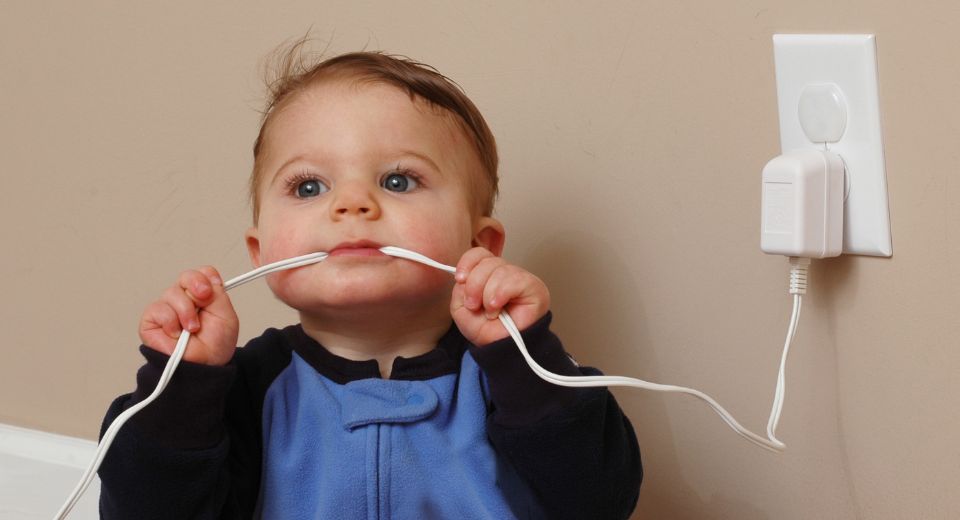
Author: Pediatrician Jyotsna Keni, MD
September is National Baby Safety month. It offers a great chance for parents and retailers to brush up on baby-proof safety standards and tips.
Safe Sleep Practices
In an ongoing effort to protect infants while they sleep and reduce the risk of sleep-related infant death, the American Academy of Pediatrics (AAP) has the following is a list of recommendations to keep your baby safe
- The baby should sleep on a firm, flat, non-inclined surface that, at a minimum, meets federal safety standards for cribs, bassinets, play yards, and bedside sleepers. Parents should not use products for sleep that are not specifically marketed for sleep.
- Has your crib been recalled? Check cpsc.gov/Recalls to make sure.
- Sitting devices, such as car seats, strollers, swings, infant carriers, and infant slings, are not recommended for routine sleep in the hospital or at home, particularly for infants younger than 4 months.
- Breastfeeding reduces the risk of sleep-related infant deaths. While any human milk feeding is more protective than none, two months of at least partial human milk feeding has been shown to significantly lower the risk of sleep-related deaths.
- The AAP recommends that parents sleep in the same room – but not in the same bed as a baby, preferably for at least the first six months.
- Avoid parent and infant exposure to nicotine, alcohol, marijuana, opioids, and illicit drugs.
- Make sure the baby receives routine immunizations.
- Pacifier use is associated with reducing risk.
- Avoid the use of commercial devices that claim to reduce the risk of SIDS or other sleep-related deaths. There is no evidence that any of these devices reduce the risk of these deaths. Importantly, the use of products claiming to increase sleep safety may provide a false sense of security and complacency for caregivers. Do not use home cardiorespiratory monitors as a strategy to reduce the risk of SIDS.
- Supervised, awake tummy time is recommended. Parents are encouraged to place the infant in tummy time while awake and supervised for short periods of time beginning soon after hospital discharge, increasing incrementally to at least 15 to 30 minutes total daily by 7 weeks of age.
- There is no evidence to recommend swaddling as a strategy to reduce the risk of SIDS. If infants are swaddled, always place them on the back. Weighted swaddles, weighted clothing or weighted objects on or near the baby are not safe and not recommended. When an infant shows signs of attempting to roll (usually at 3 to 4 months but may occur earlier), swaddling is no longer appropriate, as it could increase the risk of suffocation.
Furniture and Equipment
When choosing the right furniture or equipment for your baby, safety is often the most important factor. The following are some helpful tips when evaluating new and used items
Crib and Playpens: In 2011 new safety guidelines were established to make sure that cribs were safer for babies. Please check the Consumer Product Safety Commission’s website (http://www.cpsc.gov) for a list of recalled cribs and other items.
- Crib spindles should be no more than 2-3/8 inches apart. This is about as wide as a 12 ounce drink can.
- Make sure that all joints are secure, that there are no loose screws, nuts, plastic parts or springs.
- Make sure that there is no peeling paint or splintered wood.
- The mattress should fit securely in the crib, leaving no gaps around where your baby could get stuck or trapped.
- Drop side cribs should not be used for babies or children. Babies and children can get trapped in the crib. The U.S. is no longer making or selling drop side cribs.
- Cribs should be free of pillows, comforters, blankets, bumper pads and stuffed animals. Use a tight fitting sheet to cover the mattress.
- Make sure there are no dangling cords from window blinds, lamps or mobiles near the crib.
- If using a playpen or Pack and Play® make sure the sides lock securely. Playpens should be free of pillows, comforters, blankets, bumper pads and stuffed animals
High Chair: When your baby is 5 or 6 months old and can sit up without support, they can use a high chair.
- The base should be wider than the top of the chair so it does not tip over easily.
- Make sure the tray latches securely.
- Always use a 5 point harness when your baby is in the high chair, and never leave them alone in the chair – not even for a minute.
Infant Swing: A fussy baby who cries a lot may be calmed by an infant swing. The swinging movement often soothes the baby.
- Always use a 5 point harness to secure the baby in the swing and never leave a baby alone in a swing.
- If the baby falls asleep in the swing, they should be gently removed from the swing and placed in his crib, on their back.
Car Seat: An approved car seat is the most important piece of equipment you can have for your baby’s safety.
- Children under age 8 must be properly buckled into a car seat or booster in the back seat.
- Children under 2 years old must be rear-facing (facing backwards) unless they weigh 40 pounds or more or are 40 inches tall or more. Facing the rear is the safest way for a baby or toddler to ride.
- The harness straps should be snug and placed at or below the shoulder level.
- It’s against California law to leave a child who is 6 years of age or younger alone in the car without the supervision of a person at least 12 years old.
Baby Walkers: Not a good idea and should not be used! Children don’t need them to learn to walk and they can be very dangerous. Each year many babies are seriously injured from falls while in walkers.
Smoke and Carbon Monoxide Detectors: Should be installed in the home and checked regularly to make sure they are working correctly.
High Up is High Risk: Keep infant seats off high surfaces and make sure your baby is properly strapped in.
- Keep hold of children on changing tables, beds, couches, exam tables, counters and chairs.
- If car seats are used as a carrier, they should be placed on a hard, flat floor, where there is no danger of falling over. Car seats should not be used as a sleep surface.
Miscellaneous Safety Measures
An integral part of helping your baby grow is providing a healthy and safe environment. The following are some tips for providing a safe environment for them to explore, learn, and thrive.
Toys:
- Marbles, plastic bags, balloons, magnets and toys with small loose parts or buttons, are all things that can hurt your baby if they are swallowed.
- Crib toys should not have parts that can be chewed off or swallowed. Don’t tie toys to the crib. The baby’s neck, fingers, and toes can get tangled in the string.
- Any toy that can fit through a cardboard toilet tissue roll is too small to be within the reach of children under 3 years of age.
Pets: Don’t leave your baby alone in a room with a dog, cat, or any pet. Even if your pet seems gentle, it could think your baby is a threat, and could harm him.
Food: Hold your baby when feeding.
- Propping the bottle or giving strained food through a bottle can cause choking. The milk or formula that stays in the mouth when a bottle is propped can lead to tooth decay later.
- If your baby uses a pacifier, do not tie the pacifier to the baby’s clothes or around the neck.
- Foods to avoid until the baby has a full set of teeth and can chew well: apple chunks or slices, grapes, cut-up hot dogs, popcorn, nuts, seeds, round candies, hard chunks of uncooked vegetables.
- Sometimes well intending siblings like to share their food with their younger siblings, creating a choking risk. Do not leave your small child unattended during meals.
- Never carry or handle hot liquids around your baby.
Clothing:
- Take strings off the bottoms of sleepers so they don’t get wrapped around the baby’s neck or toes.
- Check all clothing for loose buttons that could be swallowed or strings that could get wrapped around your baby’s neck, fingers, or toes.
Water Safety: Drowning is the second leading cause of injury deaths among US children ages 1 to 4 years and the fifth leading cause of injury deaths among children younger than 1 year.
- Never leave your child alone in the bathtub, hot tub or backyard pool – even for a second If you must leave for any reason, take your child with you. Young children can drown very quickly in a small amount of water.
- When giving a baby a bath, use an infant tub with a non-skid mat to keep your baby from slipping.
- Always test the water with your elbow first to avoid burning the baby’s delicate skin. Hot water heaters should be set at 120 degrees Fahrenheit to avoid burns.
- Babies have drowned while using bath seats, so you should always keep your baby within your reach. If you do use a bath seat, stop using it when your baby is old enough to start pulling up to a standing position. Bath seats can tip over and infants and toddlers can climb out. The seat can come loose from the suction devices that attach the seat to the bathtub bottom. Baby bath seats are not safety devices and do not take the place of adult supervision.
- Do not leave buckets or inflatable pools around with water in them. Babies can fall in headfirst and drown.
When Baby Starts to Crawl:
- When your baby starts to crawl or walk, long or sharp objects such as spoons, lollipops, or Popsicle sticks can be harmful. If he falls while the item is in his mouth or near the eyes, it could hurt him.
- Outlet covers should be put in unused outlets and furniture should be secured to walls to avoid the toddler pulling it over and causing serious injury.
- Electric wires should be secured to the floor or under rugs to prevent injury.
- Safety gates should be placed at the top and bottom of the stairs and 2nd floor windows should remain locked or have a window guard on them to prevent children from falling through the screen.
- Furniture should be moved away from windows so small children can’t climb up and fall out the window.
- Poison-proof your home:
- If you carry medicine, cigarettes or lighters in your purse, keep your purse out of your toddler’s reach.
- Move cleaning products and medicines to high cupboards or put safety latches on low cupboards
Many houseplants are dangerous if eaten. If you don’t know if your houseplants are safe or if you think someone has eaten or drank something poisonous, call the Poison Control Center at 1-800-222-1222
The information provided is for general interest only and should not be misconstrued as a diagnosis, prognosis or treatment recommendation. This information does not in any way constitute the practice of medicine, or any other health care profession. Readers are directed to consult their health care provider regarding their specific health situation. Marque Medical is not liable for any action taken by a reader based upon this information.

